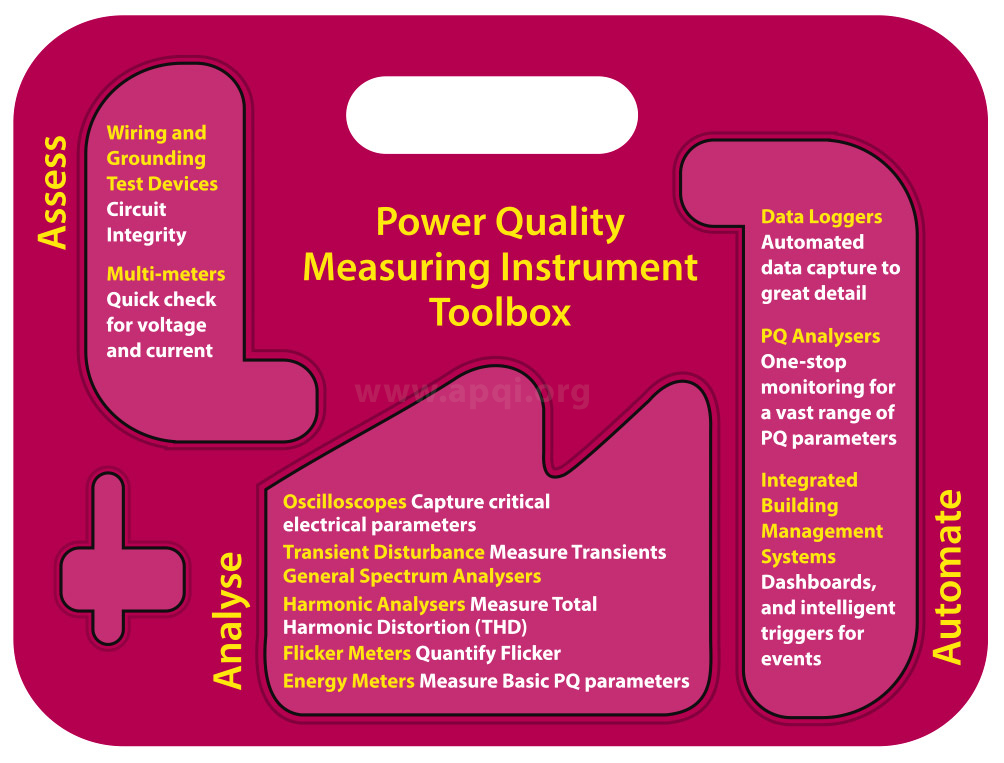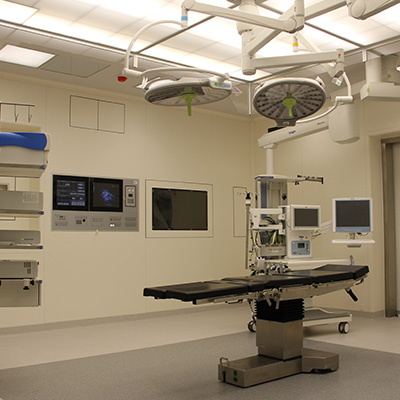Published On: Aug 09, 2019
The biggest challenge in improving Power Quality is perhaps finding and scoping its exact measure. Measurement and execution dependency on multiple agencies, such as equipment vendors, electrical contractors, energy or PQ auditors etc. Utilities further add to the complexity of this challenge. Also, PQ measurement tools are relatively costly, at least initially, and the data is difficult to decipher and act on. A good and essential instrument Toolbox for PQ and related tests can help the Maintenance Managers to control the damage and estimate problems much before they occur.
INTRODUCTION
Awareness about PQ and it’s impact on productivity or equipment health continues to remain low, particularly in the Indian context. The problems related to PQ are on the rise. Whether its street lights or power electronics, PQ is affecting the facilities in more ways than the Facility Managers usually think. On the receiving end of all the issues arising from poor PQ are the Electrical Facility and Maintenance Managers/in-charges, who are responsible for reliability and availability of power and electrical infrastructure.
But, interestingly, still a vast majority of the Maintenance Managers or Technicians from MSME sector, main stay of Indian industry, do not appreciate the importance of solving the root cause of PQ issues, as much as they should. Problem is more severe in commercial buildings where outsource panacea pervades all. Buildings are main stay of service sector economy and becoming increasingly intelligent or digitally driven.
Their problems could range from the long list of parameters that must be integrated to improve PQ or could arise from a poor understanding of these parameters itself. Often, the end result is Managers resort to quick fixes, or end up adopting a solution that solves the problem in the short run. In the process they leave a huge probability of it resurfacing in the future.
There are several examples – starting from repeated electricity bill penalties for non-maintenance of Power Factor to tripping of critical equipment such as circuit breakers or motors, stoppage of lifts etc. Maintenance Managers are not always able to uncover the real issues or root causes for two key reasons – lack of bandwidth and the right measurement Toolbox for assessing PQ status.
In this blog, we highlight the different types of instruments that are available to the Maintenance Managers to measure PQ – with a broad classification of the facilities and ideal instrument set that they must acquire.
UNDERSTANDING PQ MEASUREMENT – A QUICK OVERVIEW
PQ Measurement involves gathering, analysing and interpreting raw measurement data into useful insights about the quality of electrical power. The data is gathered usually for various characteristics of voltage and current, over a period of time. While most of the measurements have been performed manually in the past, the advances in data logging, IoT have now enabled automated data collection and analysis. Many instruments come with interpretation capabilities enabled by data analytics, trend spotting analysis etc.
The trend is clearly toward minimum human intervention for measurement and analysis.
POWER QUALITY MEASUREMENT – HOW AND WHERE TO START?
In the previous editions of this blog, we have discussed about specific instrument tools which can be leveraged to measure parameters that define the PQ. From the readily available panel meter, or Smart Meter to the highly sophisticated PQ Analyser, the range of measuring instruments available is huge and at times puzzling enough for a beginner to get started.
On the other side the PQ events too form a vast range – from rapid transient over voltages with a timeframe of microsecond to outages lasting for hours together. And that’s not all, as PQ issues are found in steady-state phenomena, such as harmonic distortion, and difficult to predict phenomena, such as voltage flicker.
Given this range on both the sides, PQ measuring instruments and the issues these instruments can identify, the starting point is very important to make meaningful progress.
A good starting point could be considered as the one which helps to measure the most frequent and the most critical PQ issues, either related to Voltage received or Current drawn, in the facility. Now, these issues may vary significantly for each facility. For instance, a Steel manufacturing facility will experience a different level and type of harmonics from that experienced by a Data Center.
This is also defined by the business goals or key success factors of the business. To refer to the earlier example, 1 minute of downtime in data center may be fatal to the business. This may not be the case in a steel manufacturing unit. A Data Center will therefore have to invest in a high-end PQ Analyser for continuous monitoring and a Steel manufacturing unit can improve the PQ with periodic measurement. A commercial building with building energy management or building automation system may have integrated PQ monitoring facility.
The exact measuring instruments that should be included in the PQ Measurement Toolbox of the facility will thus depend on the nature of issues and frequency of monitoring. In case of PQ, a combination of instruments is also required to investigate certain specific phenomenon such as high Electro-Magnetic Field.
The basic measuring instruments that can be considered to be a part of the PQ Measurement Toolbox include:
|
 |
PQ MEASURING INSTRUMENTS AND APPLICATIONS – A BRIEF INTRODUCTION
Wiring and Grounding Test Devices
Wiring and grounding faults are simple but difficult to spot, especially for a facility that’s up and running. Also, the faults tend to emerge as the facility ages or expands. Many of the PQ related issues are rooted in improper wiring and grounding issues. These instruments help to measure and detect isolated ground shorts, ground impedance, open grounds, open neutrals, or open hot wires.
Advantage – Easy and quick instrument to test for circuit integrity. Many of the PQ issues are related earthing and grounding can be detected quickly and using inexpensive methods.
Multimeters
Overvoltage, undervoltage, voltage unbalance are the root causes of several PQ related issues. A simple multi-meter that is capable of measuring Phase-to-ground, phase-to-neutral voltage, neutral to ground and phase-to-phase voltage in three phase system. Based on these measurements, the Managers might have to calculate peak method, averaging method and true rms to understand the underlying issues.
Advantage – Make a quick check for voltage and current levels in the facility – fundamental to the PQ
Transient Disturbance Analysers
Transient disturbance analysers are designed to capture store and display very short-duration disturbances, often at sub-cycle level. The sampling rates of these instruments are very high to the tune of 2 to 4 million samples per second. These specialist devices can capture disturbances in environment with high power electronics density.
Advantage – Highly useful to understand the menace caused by Transients, which are very difficult to measure or analyse with other methods.
Harmonic and Spectrum Analysers
Harmonic analysers, also known as harmonic meters measure and record harmonic distortion data. The instrument construction includes a meter with a waveform display screen, voltage leads and current probes. Advanced harmonic analysers come with capability to characterize the changes in harmonic distortion levels with change in loads or power inputs.
Advantage – With Harmonic Analysers one can calculate K factor to de rate transformers, Total Harmonic Distortion (THD) as a percentage of the fundamental and harmonic frequency associated with the current and voltage up to the fiftieth harmonic.
Oscilloscopes
Oscilloscopes help to measure repetitive high-frequency waveforms with noise superimpositions. With sampling rates that are far higher than transient disturbance analysers, Oscilloscopes help to capture data which is not in the range of harmonic analysers.
Advantage – With multiple channels and digital storage, Oscilloscope help to capture more than one electrical parameter.
Flicker Meters
Flicker meters have emerged as a reliable instrument for comprehensive measurement of flickers, beyond visual observation. The principle of measuring flickers is based on demodulating the signal and then weighing it as per established ‘flicker curves’. These are then processed statistically, to demonstrate the exact values. It is advisable to select meters that perform measurement and analyse the curves as per IEC 61000-4-15.
Advantage – Clear, compliance driven instrument to measure flickers for specific critical instruments or points in the electrical network. Especially, useful to quantify flicker that may not be exactly demonstrated or visible to the human perception.
Smart Energy Meters
The Smart Energy Meters offers a wide range of possibilities when it comes to measurement of current and voltage waveforms. Advanced Smart Meters can measure up to 150+ parameters pertaining to electrical power. It’s a huge capability when it comes to analysing the Power Quality. However, Smart Meters lack the computational and statistical functions of specialised meters discussed above. In most cases, the data will have to be specifically extracted and analysed with tailor-made statistical model to spot meaningful insight. However, when selecting the meter it’s important to observe and choose the ones which give an insight into Power Quality parameters in addition to the energy consumption.
Advantage – Easily coupled with energy monitoring investments, can specifically be applied to analyse PQ parameters to a satisfactory depth. Cloud based capability can make smart meters very handy to understand PQ environment.
PQ Analysers
PQ Analysers stand at the top of the pyramid when it comes to measuring and analysing PQ parameters. The advanced analysers are not just able to capture a multitude of data, continuously, but with intelligent software can highlight the outlier events and spot trends, automatically. The size for this device is getting smaller, connectivity capacities are expanding and with powerful analytical software it is now possible to eliminate the human intervention. Relatively higher costs of Power Analysers and a ‘reactive’ tendency when it comes to measurement of PQ parameters has limited the penetration of the PQ Analysers.
Advantage – In many ways, a one-stop-solution instrument for measuring and monitoring a vast range of PQ parameters with minimal manual intervention.
INSTRUMENT SELECTION CHECKLIST ESSENTIALS
Additional factors that may be useful for selecting the measuring instrument include:
- Channels for voltage and/or current
- Temperature specifications of the instrument
- Build and Construct of the instrument
- Compatible Input voltage range
- Power needs and Sources
- Three-phase voltage measurement options
- Current measurement – sensitivity and granularity
- Mounting and Movement (Portable, Rack-mounted etc.)
- User Interface (Analog/Digital/HMI Panels, Graphics etc.)
- Storage Memory, Processor and communication (modem/network interface, Wifi connectivity, In-device memory etc.)
- User and Support Documentation
- Analysis software compatibility (for data exports, Operating Systems, SCADA/MES interfacing etc.
CONCLUSION
Power Quality Measurement is largely instrument dependent. Further, effective PQ measurement requires dealing with huge data sets, and statistical analysis. Different organisations have their own ways to measure, assess and deal with PQ issues which defines their choice of measuring instruments. It is advisable to maintain a basic set of instruments in-house, to measure the fundamental PQ parameters of Voltage and Current. Depending of the facility’s requirement, advanced PQ measuring instruments can be added to the Toolbox. While the Maintenance Managers can rely on team for basic measurements of the key electrical parameters, their analysis for PQ insights may require training on case to case basis. Further, to analyse the output from advanced PQ measuring instruments such as Oscilloscopes or PQ Analysers, Maintenance Managers will have to develop a clear understanding of the scenarios and technical details of PQ. One must avoid the mentality of acquiring PQ measurement tools solely on the basis of “Neighbour’s Envy Owners Pride” since primary objective is to understand PQ data and impact that poor PQ can cause.
What remains beyond debate is the need for developing a PQ measurement Toolbox – which includes measuring instruments, back-end processes to use the instruments and compatible software solutions for quick analysis and actionable insights. It’s the first definitive step to committing long-term improvement of PQ in the facility.
REFERENCES
- A New Study on Handheld Flicker Meters – https://www.energy.gov/eere/ssl/articles/new-study-handheld-flicker-meters-0
- A quick guide to making PQ Measurements – https://www.ecmweb.com/power-quality/quick-guide-making-pq-measurements







